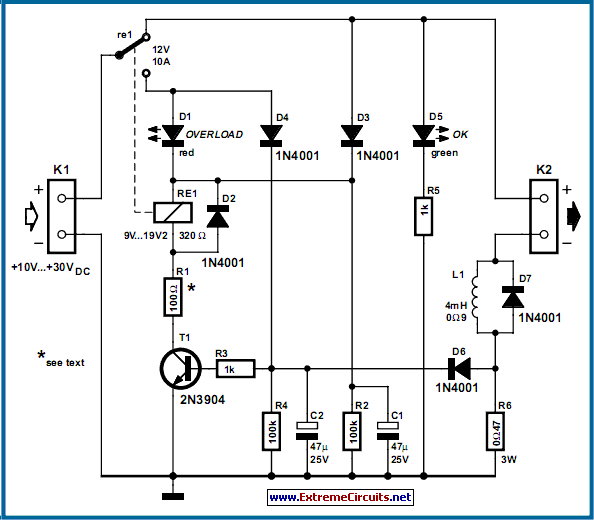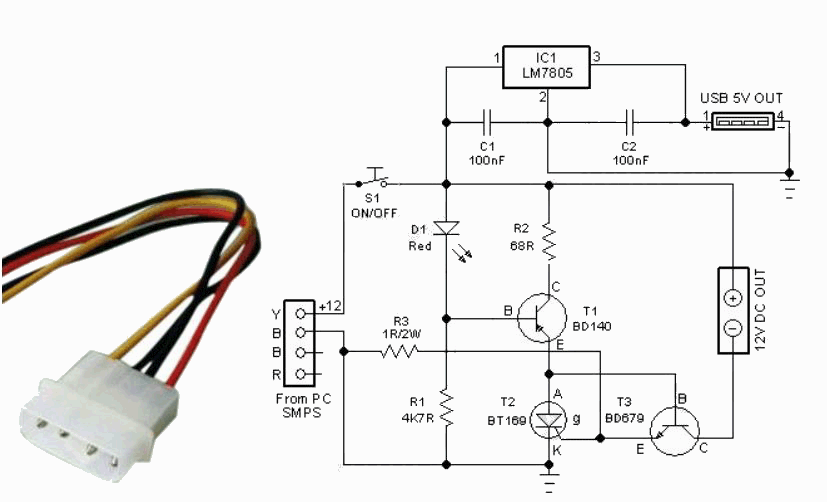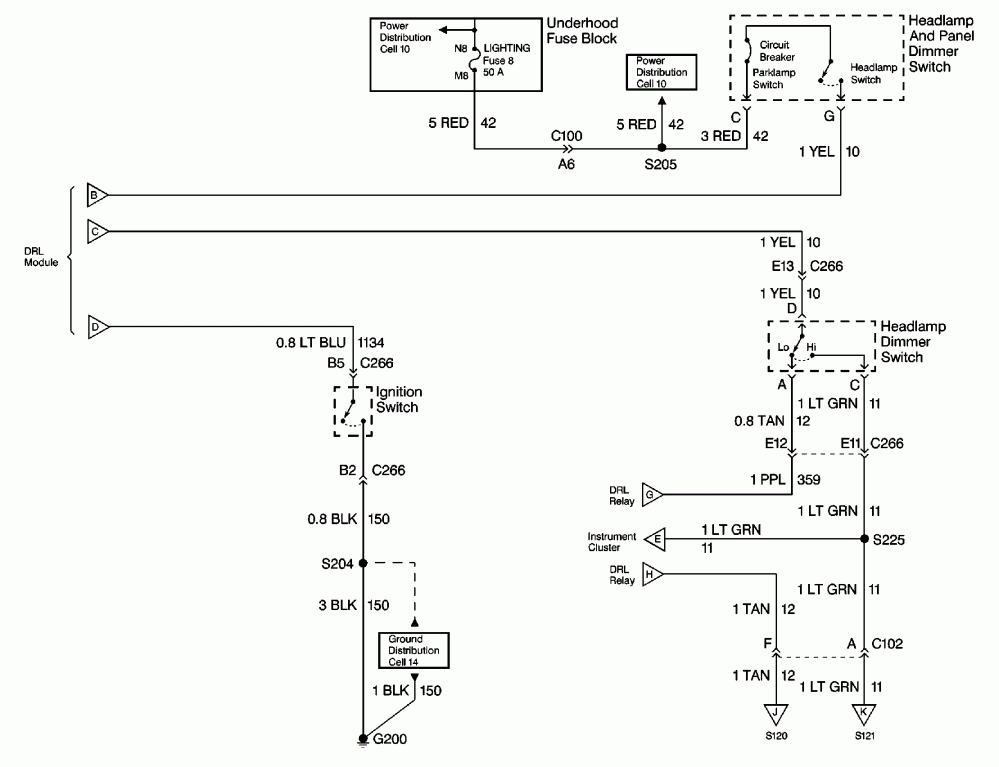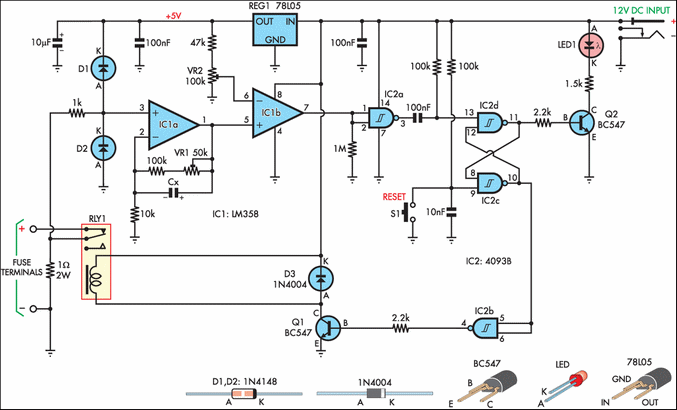
Fuse Saver

This circuit is particularly beneficial for hobbyists utilizing a breadboard to experiment with ideas, alongside a simple homemade DC power supply comprising a transformer, rectifier, smoothing capacitor, and protective fuse, which lacks overcurrent protection. In this design, resistor R6 serves as the detecting element. Under normal conditions, the voltage drop across R6 is insufficient to activate transistor T1. The resistance value of R6 can be adjusted to set a different cut-off current, as per Ohm's Law, if necessary. When a short circuit occurs in the load, the voltage increases rapidly, causing T1 to conduct. This action engages the relay, switching its contacts to cut off power to the external circuit and instead directly powering the relay coil, latching it in this state. The circuit remains in this condition until the primary power supply is turned off. Capacitors C1 and C2 retain sufficient charge (via diodes D3, D4, and D6, which prevent charge loss to the rest of the circuit regardless of its state) to keep T1 activated and power the relay during the switching process, while resistors R2 and R4 provide slow discharge paths. LEDs D1 (red) and D5 (green) indicate the circuit's operational state. Inductor L1 mitigates the inrush current when the circuit is powered on, preventing immediate circuit cutoff. Diodes D2 and D7 offer standard back-emf protection across the coils. The circuit's input connects to the main transformer-rectifier-capacitor-fuse power supply via K1, and the output connects to the experimental load through K2. It is important to ensure that the input voltage is a floating supply if Vout is grounded through the load since Vin and Vout must not be interconnected. Consideration must be given to several components, particularly the relay Re1. For the prototype, a relay from Maplin, part number YX97F, was used, featuring a coil resistance of 320 ohms, which, along with R1, forms the collector load for T1. The relay's nominal pull-in voltage range is 9 V to 19 V, thereby restricting the input power supply voltage to approximately 10 V to 30 V (DC only). R1 can be replaced with a wire link for input voltages below 10 V or increased in value, determined by Ohm's Law or empirical testing, for input voltages exceeding 30 V. Coil L1 was sourced from Farnell, part number 581-240. It is crucial to use a slow-blow type protective fuse for the input power supply; fast fuses may blow before the relay has the opportunity to activate. This device is intended to preserve fuses, not to replace them. A mains transformer must always be fused if it is not designed to operate safely, i.e., without posing a fire hazard, even if its output experiences a continuous short-circuit fault.
The described circuit serves as an effective overcurrent protection mechanism for experimental setups using a breadboard. The core functionality relies on the rapid detection of excessive current through R6, which triggers T1 to activate the relay, thus disconnecting the load and protecting the power supply. The inclusion of capacitors C1 and C2 ensures that the relay remains engaged long enough to prevent any transient interruptions in the power supply to the relay coil during the switching process. This design minimizes the risk of damage to the circuit components caused by short circuits while allowing for flexibility in adjusting the cut-off current through R6.
The use of LEDs D1 and D5 provides a visual indication of the circuit's status, enhancing usability by allowing the operator to quickly ascertain whether the circuit is operational or has entered a fault state. The inductor L1 plays a critical role in controlling the initial current surge when the circuit is powered on, thereby protecting sensitive components from potential damage due to inrush currents.
Overall, this circuit not only enhances the safety of experimental electronics but also promotes efficient troubleshooting and development practices for hobbyists and engineers working with breadboard setups. The careful selection of components, such as the relay and fuse type, further contributes to the reliability and effectiveness of the circuit in various applications.This circuit will be particularly useful to those hobbyists who use a breadboard` to try out ideas and who also use a simple home-made` DC power supply consisting of a transformer, rectifier, smoothing capacitor and protective fuse, that is, one without over current protection! In this circuit, the detecting element is resistor R6. Under normal co nditions, its voltage drop is not high enough to switch on transistor T1. The value of R6 can be altered to give a different cut-off current, as determined by Ohm`s Law, if required. When a short circuit occurs in the load, the voltage rises rapidly and T1 starts to conduct. This draws in the relay, switching its contacts, which cuts off power to the external circuit, and instead powers the relay coil directly, latching it in this second state.
The circuit remains in this state until the primary power supply is switched off. Capacitors C1 and C2 hold enough charge (via D3, D4 and D6, which prevent the charge from being lost to the rest of the circuit, whichever state it is in) to keep T1 switched on and power the relay while it switches over, and R2 and R4 provide slow discharge paths. LEDs D1 (red) and D5 (green) indicate what state the circuit is in. Inductor L1 slows the inrush of current when the circuit is switched on, which would otherwise cut off the circuit immediately.
D2 and D7 provide the usual back-emf protection across the coils. In use, the input of the circuit is connected to the main transformer-rectifier-capacitor-fuse power supply via K1, and the output is connected to the (experimental) load via K2. Note that the input voltage must be a floating supply if Vout is grounded via the load, as Vin and Vout must not be connected together.
Some consideration needs to be given to a number of components. First, the choice of relay Re1. For the prototype, this was obtained from Maplin, part number YX97F. This is has a coil resistance of 320, which with R1 forms the collector load for T1. Its allowed pull-in voltage range is nominally 9 V to 19 V, which limits the input power supply voltage to between around 10 V to 30 V (DC only). R1 could be replaced by a wire link for operation at input voltages below 10 V, or increased in value, as determined by either the application of Ohm`s Law once more or trial and error, for an input voltage above 30 V.
Coil L1 was obtained from Farnell, part number 581-240. Finally, the protective fuse for the input power supply should be a slow-blow` type; fast` fuses will rupture before the relay has time to switch. Also note that this device is meant to save fuses, not replace them. A mains transformer must always be fused if it is not designed to run safely, i. e. , without presenting a fire hazard, even if its output has a continuous short-circuit fault. 🔗 External reference
The described circuit serves as an effective overcurrent protection mechanism for experimental setups using a breadboard. The core functionality relies on the rapid detection of excessive current through R6, which triggers T1 to activate the relay, thus disconnecting the load and protecting the power supply. The inclusion of capacitors C1 and C2 ensures that the relay remains engaged long enough to prevent any transient interruptions in the power supply to the relay coil during the switching process. This design minimizes the risk of damage to the circuit components caused by short circuits while allowing for flexibility in adjusting the cut-off current through R6.
The use of LEDs D1 and D5 provides a visual indication of the circuit's status, enhancing usability by allowing the operator to quickly ascertain whether the circuit is operational or has entered a fault state. The inductor L1 plays a critical role in controlling the initial current surge when the circuit is powered on, thereby protecting sensitive components from potential damage due to inrush currents.
Overall, this circuit not only enhances the safety of experimental electronics but also promotes efficient troubleshooting and development practices for hobbyists and engineers working with breadboard setups. The careful selection of components, such as the relay and fuse type, further contributes to the reliability and effectiveness of the circuit in various applications.This circuit will be particularly useful to those hobbyists who use a breadboard` to try out ideas and who also use a simple home-made` DC power supply consisting of a transformer, rectifier, smoothing capacitor and protective fuse, that is, one without over current protection! In this circuit, the detecting element is resistor R6. Under normal co nditions, its voltage drop is not high enough to switch on transistor T1. The value of R6 can be altered to give a different cut-off current, as determined by Ohm`s Law, if required. When a short circuit occurs in the load, the voltage rises rapidly and T1 starts to conduct. This draws in the relay, switching its contacts, which cuts off power to the external circuit, and instead powers the relay coil directly, latching it in this second state.
The circuit remains in this state until the primary power supply is switched off. Capacitors C1 and C2 hold enough charge (via D3, D4 and D6, which prevent the charge from being lost to the rest of the circuit, whichever state it is in) to keep T1 switched on and power the relay while it switches over, and R2 and R4 provide slow discharge paths. LEDs D1 (red) and D5 (green) indicate what state the circuit is in. Inductor L1 slows the inrush of current when the circuit is switched on, which would otherwise cut off the circuit immediately.
D2 and D7 provide the usual back-emf protection across the coils. In use, the input of the circuit is connected to the main transformer-rectifier-capacitor-fuse power supply via K1, and the output is connected to the (experimental) load via K2. Note that the input voltage must be a floating supply if Vout is grounded via the load, as Vin and Vout must not be connected together.
Some consideration needs to be given to a number of components. First, the choice of relay Re1. For the prototype, this was obtained from Maplin, part number YX97F. This is has a coil resistance of 320, which with R1 forms the collector load for T1. Its allowed pull-in voltage range is nominally 9 V to 19 V, which limits the input power supply voltage to between around 10 V to 30 V (DC only). R1 could be replaced by a wire link for operation at input voltages below 10 V, or increased in value, as determined by either the application of Ohm`s Law once more or trial and error, for an input voltage above 30 V.
Coil L1 was obtained from Farnell, part number 581-240. Finally, the protective fuse for the input power supply should be a slow-blow` type; fast` fuses will rupture before the relay has time to switch. Also note that this device is meant to save fuses, not replace them. A mains transformer must always be fused if it is not designed to run safely, i. e. , without presenting a fire hazard, even if its output has a continuous short-circuit fault. 🔗 External reference





